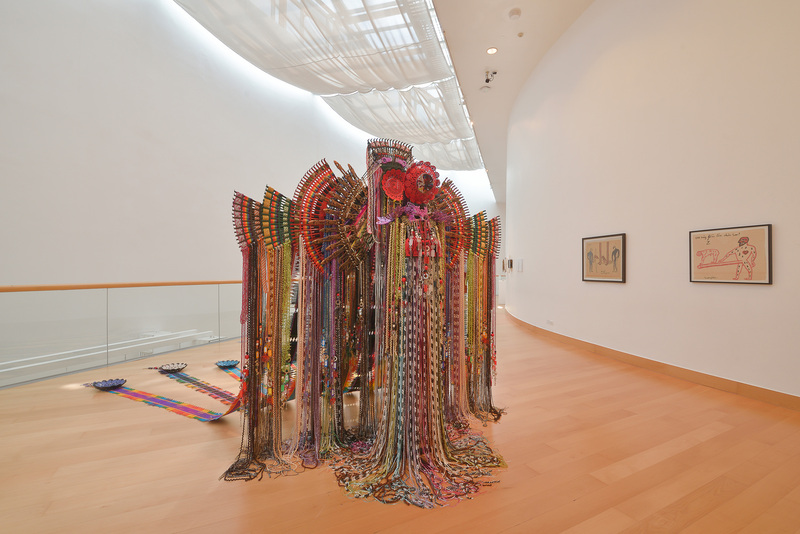Bangkok: Spectrosynthesis II: Exposure of Tolerance
By David Willis

Installation view of ANNE SAMAT’s Conundrum Ka Sorga (To Heaven), 2019, rattan sticks, yarns, washers, rakes, PVC chains, home and fashion accessories, kitchen and garden utensils, and stationery items, dimensions variable, at "Spectrosynthesis II: Exposure of Tolerance," Bangkok Art and Cultural Centre (BACC), 2019. Courtesy BACC and Sunpride Foundation.
Spectrosynthesis II: Exposure of Tolerance
Bangkok Art and Culture Centre
Bangkok
A massive exhibition of LGBTQ art, “Spectrosynthesis II: Exposure of Tolerance” was the sequel to the 2017 iteration staged by the Hong Kong-based Sunpride Foundation at the Museum of Contemporary Art in Taipei. Featuring 58 artists working in a range of media, “Spectrosynthesis II” was loose and inclusive in its purview. Although it purported to be about queerness in Asian contexts, it sometimes felt more like a roll call of queer Asian artists, since the exhibition included works ostensibly unrelated to queerness, such as a minimal brick painting by Maria Taniguchi that seemed out of place in the often hyper-flamboyant presentation. Further confusing the matter was the inclusion of heteronormative painter Angkrit Ajchariyasophon, whose rainbow-colored polyptychs hung prominently in the spiral rotunda of the Bangkok Art and Culture Centre. Titled Celebrated Phenomenal of Colors (2010–19), the work was inspired not by the pride flag but by Isaac Newton's light spectrum experiments—evidence that even a coincidental connection with queer culture was sufficient to merit inclusion.
Curatorial quibbles aside, the show captivated with a mixture of established figures alongside younger artists. Of the former, Dinh Q. Lê presented a pair of his signature woven photo-paintings and a giant cascading photo-print incorporating images from Vietnamese popular media and gay porn. These are part of the artist’s recent project exploring explicit depictions of homosexuality in the visual landscape of Vietnam, where pornography is officially forbidden yet remains accessible online. Nearby, renowned textile artist Anne Samat’s colorful mixed-media installation evokes an androgynous figure under a veil, hinting at the issue of same-sex marriage, which among Asian territories is legal only in Taiwan. The assemblage is embedded with the names of notable queer individuals, such as trans model Amanda Lepore, and the late emerging photographer Ren Hang, whose sensual portraits were also in the exhibition.
Other notable works included Ramesh Mario Nithiyendran’s playfully garish ceramic sculptures, full of phallic symbolism and vagina dentata, and Su Hui-Yu’s video installation Nue Quan (2015), inspired by the lurid media scandal that gripped Taiwan in 2001 after a gay BDSM encounter resulted in a man’s accidental death. While Nithiyendran taps into his Tamil heritage with his hermaphroditic idols (a feature in Hindu iconography for millenia), Su’s darkly mesmerizing video speaks more directly to contemporary representations of queer sexuality, prompting us to consider the prejudices underlying the sensational reporting of the incident, not least the long-standing belief that non-normative sexual behavior is inherently risky.
The show’s standout work was undoubtedly Thai artist Arin Rungjang’s new commission, Welcome To My World, ‘Tee’ (2019). Five gigantic video projections depict a nude trans woman reclining majestically like Titian’s Venus of Urbino (c. 1538), her male genitalia conspicuously on display. The videos are accompanied by a lengthy text component, in which Rungjang recounts his own formative experiences of racism and sexual abuse, before sharing the life story of his model, detailing the intersectionally aggravated struggles of a lower-class katoei (a derogative term for gender-non-conforming people in Thailand).
It was the inclusion of works such as Rungjang’s, which document the daily challenges faced by queer Thais, that made this show an important milestone for the representation of queerness in its local context. Sudaporn Teja’s film, for instance, tells the tale of a young comatose patient whose partner lacks the legal right to withdraw life support as same-sex unions are unrecognized in Thailand. Meanwhile, Ohm Phanphiroj’s documentary features boys as young as nine recounting how they were entrapped in prostitution in Bangkok, yet they also describe their dreams, such as buying a house or becoming a break-dancer. In this manner, “Spectrosynthesis II” not only celebrated queer art and artists, but also emphasized that despite Thailand’s superficial reputation among foreign vacationers for being a “queer friendly” society, when it comes to the rights and representation of all sexualities and genders, there is still a long way to go.
.jpg)






